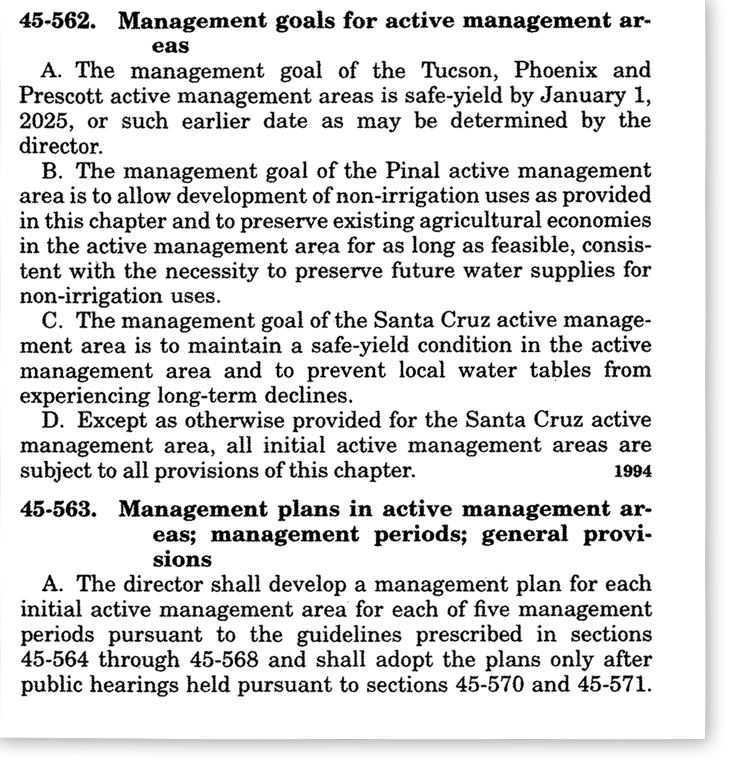Public Policy Review

We are at a critical juncture in water management in Arizona. We are increasingly relying on known renewable water supplies, particularly Central Arizona Project water. Meanwhile drought continues, and the effects of climate change on our water supplies is unknown. Also uncertain is the amount of water to be reused and for what purposes. The 1980 Groundwater Management Act provides a framework for groundwater regulation, but, interestingly, regional planning within the Active Management Areas is not mandated. Nor does the GMA address surface water management or regulation of effluent utilization. Further, the GMA offers no assistance to non-AMA areas of the state in any efforts they may undertake to address water management challenges.
In its focus on groundwater management and regulation, the GMA scored some notable results. The act included a management goal for each AMA; mandated an assured water supply program; limited the expansion of agriculture; and required a series of management plans. Amendments later added the very important storage and recovery program. The major requirement for the management plans is conservation programs for each of the major water using sectors — municipal, industrial and agricultural. Conservation programs are considered an important water management tool.
The Arizona Department of Water Resources, the agency responsible for implementing and enforcing the groundwater code, is gearing up for the stakeholder process involved in developing the Fourth Management Plans for each of the five AMAs. What should the Management Plans include? The GMA offered specific direction for the first three Management Plans, particularly relating to their increasing stringency. The law, however, provides far less guidance regarding strategies the fourth and fifth plans would apply to advance the management goal of each AMA. Is that because the framers of the GMA thought we’d be close to achieving the goals by then? Or did they not want to presume what tools would be needed almost 30 years after passage of the GMA? A recent study by Northern Arizona University Professor Zachary Smith, University of Arizona Research Assistant Aaron Lien and me sheds some light on these questions.
The Arizona Department of Water Resources joined with the Arizona Water Institute to fund the study, Evolution and Evaluation of the Active Management Area Management Plans. Our research examines the management plans to date for all of the AMAs and includes numerous stakeholder interviews. Framers of the GMA indicated they viewed the management plans as a vehicle for achieving some degree of centralized control to ensure groundwater conservation. They acknowledged the need to provide time for groundwater users to adjust to the new paradigm of water regulation in the AMAs. Management periods were developed allowing for progress toward management goals over time through conservation, augmentation, reduction in the amount of groundwater used for irrigation, and use of the best available conservation practices. They also indicated that the requirements for the Fourth and Fifth Management Periods were purposely left vague to allow maximum flexibility.
Also interviewed were many water stakeholders, including current and former ADWR staff. An initial study objective was to determine if the effectiveness of the management plans to date could be assessed using data from the management plans themselves. Unfortunately, we were unable to achieve this objective because the information in the management plans is insufficient to gauge effectiveness.
We did find stakeholders holding strong opinions about the conservation programs and the process used to develop them. Overall, the general opinion is that the time has come to shift the management plan focus from regulation toward collaborative, longterm water planning. Many preferred the management plans to be actual planning documents to be implemented, rather than just a set of conservation regulations. If ADWR were to facilitate long-range planning for the AMAs, some shared governance or oversight of the process of plan development would likely have to be agreed upon.
Our study concluded with the following recommendations: ADWR should provide water use data for all sectors on at least an annual basis, with the data reported in a consistent format over time and across AMAs; State of the AMA reports should be produced on a yearly or biennial basis; ADWR should shift its focus to longterm water planning, but still maintain the current conservation programs; and Augmentation and Recharge Program and the Central Arizona Groundwater Replenishment District rules need to be reviewed and updated to ensure fairness.
The report is available at http://ag.arizona.edu/azwater/publications.php?rcd_id=54.
I will conclude by looking beyond our study which did not consider in its scope the management goals themselves or progress toward achieving them. The safe-yield AMAs were given a 45-year time horizon to meet their goal. (The Pinal AMA is the only AMA that does not have a safe-yield goal.) The GMA actually only requires an attempt to balance groundwater withdrawals with natural and artificial recharge, with no penalties imposed for failure to achieve safe-yield. Safe-yield is calculated on an AMA-wide basis.
As the 45-year timeline draws to an end, the AMAs need to understand their position relative to their long-term water management goals. In addition, collective discussions should either reaffirm the goals or suggest modifications to them. The development of the Fourth Management Plan may provide an opportunity to consider these big picture issues. Encouraging a full and open discussion of the issues helps ensure that regional water planning will proceed on a firm and solid footing.

